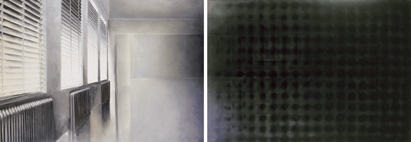"They were emblems of the menace she had felt, they were the embodiment
of the nameless, unreasonable, unmentionable disquiet she had felt that
morning. She did not believe in ghosts. But she did believe in madness.
What she feared more than the presence of the dogs was the possibility
of their absence, of their not existing at all."
(Ian McEwan: Black Dogs)1
The narrator of Ian McEwan's novel is searching. He is
trying to reconstruct and unravel the walks of life of his wife's parents,
joint only for a short time then separated. The centre of the chains of
reminiscence and narration is a gruesome story of an encounter with black
dogs; it is a story on the edge of fiction and reality which fundamentally
changes the outlook and life of June, the mother-in-law, in her youth.
This moment of experiencing violence and fear in complete defencelessness,
and yet being an act of grace becomes a fundamental reference and
collision point in the formation of the connections between the stories.
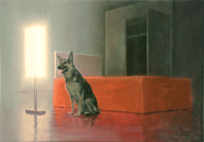
Attila Szûcs concentrates on such "high density"
moments when "our knowledge based on everyday experiences seem to become
obsolete". His pictures are visions that appear realistic. They examine
and model our possible relations with the world through painting as a system
of perception. He works within the traditional limits of oil and canvas,
choosing the relics and the spaces of our everyday environment as starting
points, with a perhaps Utopian demand that, as he does in practice, we
should in the viewing "create an empty space around the object of thought
and the tangible object without trying to create it or interpret it in
advance." 2
His elliptic painting, both in the formal and the conceptual-linguistic
sense, is the examination of the segment which shows the system of relations
of the condition that exists in the section of the circles of knowing and
not-knowing.3 His
collage objects of the early 1990s made with plaster and mixed techniques
helped in
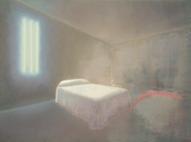 the research of such border-areas, in his case "the inspirational
power of different materials and various coincidences." The basic organising
principle, as an attempt to demarcate the unfathomable, of his plaster
works is the balance which can be created from the differences of the materials
and histories of the objects, and the pictures which are pasted on the
geometry of the gentle yet severe surface. The transition to the cleared
and homogenous world of the oil painting meant a new quality of the visualisation
of breaks and hiatus. The figure of the Untitled (Skier)
of 1994, which is cut out of
a postcard and pasted in an unpainted plaster-screen, appears doubled on
the painting Skiers (1994) in the monochrome space of the
mountain range. The figure is one of the symbols arranged according to
a code, which "enables the viewer to make a decision." It provides a point
on which the eye can follow peculiar ways and autonomies then take a rest
and return to it again and again in a circular way.4
It is at once the central element of the composition, a reference point
and the two-dimensional abstraction of the searched border state.
the research of such border-areas, in his case "the inspirational
power of different materials and various coincidences." The basic organising
principle, as an attempt to demarcate the unfathomable, of his plaster
works is the balance which can be created from the differences of the materials
and histories of the objects, and the pictures which are pasted on the
geometry of the gentle yet severe surface. The transition to the cleared
and homogenous world of the oil painting meant a new quality of the visualisation
of breaks and hiatus. The figure of the Untitled (Skier)
of 1994, which is cut out of
a postcard and pasted in an unpainted plaster-screen, appears doubled on
the painting Skiers (1994) in the monochrome space of the
mountain range. The figure is one of the symbols arranged according to
a code, which "enables the viewer to make a decision." It provides a point
on which the eye can follow peculiar ways and autonomies then take a rest
and return to it again and again in a circular way.4
It is at once the central element of the composition, a reference point
and the two-dimensional abstraction of the searched border state.
The visual start buttons of the painting of Attila Szûcs
are photographs cut out from magazines 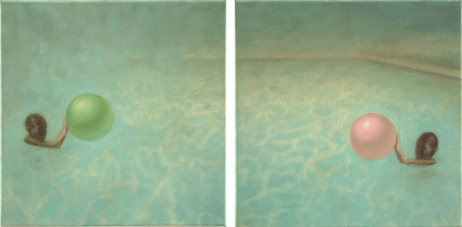
or selected from postcard boxes of second hand bookshops,
offering a definite frame and shapeable structures. The pictures taken
from the containers of collective memory, sometimes even salvaged from
the dustbin, are important devices and not only because of formal viewpoints.
The approach of Attila Szûcs is dominated by relative reservedness
and absence. He dissolves the signs of definitions and identifications
in time and space with montages of the originals or the finished pictures
and with projections of different views on each other. He
creates a situation of undefined anticipation and suspense in the composition
by distancing from the sense of identification, recognition and resemblance.
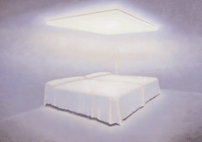 The vacuum-like state emanating from the settings of the chosen reproduction
pretending an apparent spontaneity and unanimity, and from the stories
of relative anonymity, transforms into a certain "metaphysical space".
The emptying-out shows not the absurdity of the communication, representation
and manipulation with the pictures as in the case of Luc Tuymans, but instead,
Attila Szûcs is occupied with the visualisation of the working mechanisms
of vision and attention in the special situations created by the classical
methods and materials of painting. He creates space and surface for these
"classical" problems on his pictures. In the metamorphosis of reconstruction,
while also documenting his decisions
in painting, Attila Szûcs thinks through all that excite him relating
to the pictures used as the originals. A certain object or view rises as
a signal then appears again on other works as a characteristic motive.
These repetitions in different contexts, perhaps even interwoven with
other motives reveal new aspects of the ongoing examinations of Attila
Szûcs, and, independently from his original intention, create continuously
re-arranging groups and series. Another group of the signals is that of
the "mistakes", which work like filters or in-built obstacles, appearing
as intersections of complementary meanings: the strangely broken geometrical
order in the interior of The Room with zebra skin (2001),
the ghost images and illusory reflections overlapping each other in the
Gym (2001) and Transfusion (2001), or the blurred,
flashing blind spots in the picture field like on the Table
laid, with blind spot5
(2001). These "mistakes" work as phase delays and create a tension of uncertainty
between the fact of the completion of the picture and its seemingly suspended
elaboration.
The vacuum-like state emanating from the settings of the chosen reproduction
pretending an apparent spontaneity and unanimity, and from the stories
of relative anonymity, transforms into a certain "metaphysical space".
The emptying-out shows not the absurdity of the communication, representation
and manipulation with the pictures as in the case of Luc Tuymans, but instead,
Attila Szûcs is occupied with the visualisation of the working mechanisms
of vision and attention in the special situations created by the classical
methods and materials of painting. He creates space and surface for these
"classical" problems on his pictures. In the metamorphosis of reconstruction,
while also documenting his decisions
in painting, Attila Szûcs thinks through all that excite him relating
to the pictures used as the originals. A certain object or view rises as
a signal then appears again on other works as a characteristic motive.
These repetitions in different contexts, perhaps even interwoven with
other motives reveal new aspects of the ongoing examinations of Attila
Szûcs, and, independently from his original intention, create continuously
re-arranging groups and series. Another group of the signals is that of
the "mistakes", which work like filters or in-built obstacles, appearing
as intersections of complementary meanings: the strangely broken geometrical
order in the interior of The Room with zebra skin (2001),
the ghost images and illusory reflections overlapping each other in the
Gym (2001) and Transfusion (2001), or the blurred,
flashing blind spots in the picture field like on the Table
laid, with blind spot5
(2001). These "mistakes" work as phase delays and create a tension of uncertainty
between the fact of the completion of the picture and its seemingly suspended
elaboration.
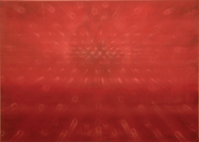
II.
"Do we have an abode? But where is it? What protects us? [
] Where
is the middle of our world? [
] Is there a place where we can retreat to?
And does that fix the world around us? What is our life really? Does it
have any direction at all? Do we have horizons and centre points? [
] Can
we devote ourselves to something? Can we find ourselves? Do we act carelessly,
and do we observe without acting? [
] Are we capable of deciphering innumerable
codes? [
] Our questions undermine and destroy our statements. They undermine
those rational systems on which our irrational abode is based. They broke
up the base and pose different questions. [
] The fertility of the questions
forms the ground of our abode. [
] Vilém Flusser6
The bed placed in the corners or in the centre of empty
spaces as a painting model is one of the oldest paradigms and metaphors
of Attila Szûcs. Covered with variously coloured veils, it stands
either lonely, or doubled and tightly next to each other, or at some distance,
a venue of seemingly limited numbers but considered as a source of our
basic experiences. 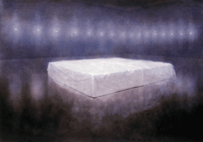 In
forming his bed-hierarchy Flusser chose suffering as the organising principle,
as he classified the functions and attainable experiences, while also reflecting
on the problems of methods. He placed love on the top of the pyramid, put
sleep on the lower right and sleeplessness on the lower left side as the
first all-embracing pair, then reading and illness as the second, and then
birth and death as the third pair. He used this hierarchy to outline our
active and passive states, our everyday functioning that pulsates between
our private sphere and the outside world, the diagram of our personal events
and reactions fitting into greater connections. Personal and archetypal
experiences, story-models and directions unfold around the bed in the interiors
of Attila Szûcs, just as during the 'philosophising' of Flusser.
The lighting and the objects connected to it transform the interiors of
our actions and life functions linked to the bed into an operation room,
mortuary, hotel room, or death cell. The installation made for the exhibition
Distance (1989), which was
In
forming his bed-hierarchy Flusser chose suffering as the organising principle,
as he classified the functions and attainable experiences, while also reflecting
on the problems of methods. He placed love on the top of the pyramid, put
sleep on the lower right and sleeplessness on the lower left side as the
first all-embracing pair, then reading and illness as the second, and then
birth and death as the third pair. He used this hierarchy to outline our
active and passive states, our everyday functioning that pulsates between
our private sphere and the outside world, the diagram of our personal events
and reactions fitting into greater connections. Personal and archetypal
experiences, story-models and directions unfold around the bed in the interiors
of Attila Szûcs, just as during the 'philosophising' of Flusser.
The lighting and the objects connected to it transform the interiors of
our actions and life functions linked to the bed into an operation room,
mortuary, hotel room, or death cell. The installation made for the exhibition
Distance (1989), which was 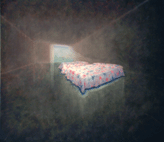 placed
in the right hand side room of the Barcsay hall, (Hungarian Fine Arts of
Academy) was an early antecedent of the settings evoking theatrical spaces.
There was a bed there with a red curtain in the background, and around
on the walls on marble-like plates there were illegible texts in antique
letters. On a line of text which stopped the entering viewer there was
a sentence written by Attila Szûcs: "Thus the bed in this sense is
a reference point, in a way like sexuality is balance, where the hand is
a gentle animal." It is an episode in the history of the painter, where
the theatricality was a model of the feasible relationship in the conditions
given by the creation. It is an emphasis of vision which makes a well-defined
viewpoint of the painter explicit. It is a stage set of an experience which
comes from an observation of life, a study of the objects and connections
of the environment, and which links the timeless, everyday and symbolic
contents of the imagination of its author.
placed
in the right hand side room of the Barcsay hall, (Hungarian Fine Arts of
Academy) was an early antecedent of the settings evoking theatrical spaces.
There was a bed there with a red curtain in the background, and around
on the walls on marble-like plates there were illegible texts in antique
letters. On a line of text which stopped the entering viewer there was
a sentence written by Attila Szûcs: "Thus the bed in this sense is
a reference point, in a way like sexuality is balance, where the hand is
a gentle animal." It is an episode in the history of the painter, where
the theatricality was a model of the feasible relationship in the conditions
given by the creation. It is an emphasis of vision which makes a well-defined
viewpoint of the painter explicit. It is a stage set of an experience which
comes from an observation of life, a study of the objects and connections
of the environment, and which links the timeless, everyday and symbolic
contents of the imagination of its author.
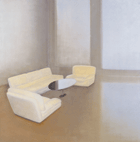 Attila
Szûcs's interiors called "clean-rooms"7,
which are only vaguely connected to the meaning of the word used in ethnography,
are the stages of the factual experience that the protectedness of our
private everyday world is but an illusion, a mere 'harmonisable' alienness.
The basic connection between the objects, which characterise the everyday
life, is perceptibly suspended or missing in the settings of the paintings.
Despite being furnished, the rooms are empty, isolation chambers, passive
spaces of synchronic existence linked to real life. The settings familiar
from holiday brochures carry, without any irony, a nostalgia mixed with
melancholy of a vanished era.
Attila
Szûcs's interiors called "clean-rooms"7,
which are only vaguely connected to the meaning of the word used in ethnography,
are the stages of the factual experience that the protectedness of our
private everyday world is but an illusion, a mere 'harmonisable' alienness.
The basic connection between the objects, which characterise the everyday
life, is perceptibly suspended or missing in the settings of the paintings.
Despite being furnished, the rooms are empty, isolation chambers, passive
spaces of synchronic existence linked to real life. The settings familiar
from holiday brochures carry, without any irony, a nostalgia mixed with
melancholy of a vanished era.
Hardly any "visitor" strays into the spaces functioning
in a suspended time. Sometimes a dog appears but mostly only objects,
Christmas tree, lights, lowered shutters, burnt out curtain, refer to
possible events. Their strange hegemony prevents the
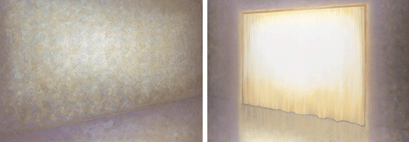 viewer from "entering",
from identifying with the objects forming the basis of the viewer's
conformity. It is a secret to what and where all is linked to; this deaf
silence, this hermetic state, the lack of the outside world beyond the
painted window, the shutter, the curtain, the dissolution of the environment
of the figures who are fixed into their actions and the scenes taking place
in the open, in outside venues. The male figure of the Jumping Figure
(1999) falls into the same void as into which the little girl is
staring in front of the broken barrier on the Untitled (1997).
As the mistake on other canvases, the presence of the void can refer to
another reference point of the rational space. In the case of the Interior
with Red Curtain (1998), in the middle of the picture, in
the transition between the spaces bordered by the blurring wrinkles of
the patterned red curtain half drawn and the shutters hardly letting through
any light, an aspiration for a more open and homogenous surface structure
appears with the examination of the formal and sensual possibilities of
colour.
viewer from "entering",
from identifying with the objects forming the basis of the viewer's
conformity. It is a secret to what and where all is linked to; this deaf
silence, this hermetic state, the lack of the outside world beyond the
painted window, the shutter, the curtain, the dissolution of the environment
of the figures who are fixed into their actions and the scenes taking place
in the open, in outside venues. The male figure of the Jumping Figure
(1999) falls into the same void as into which the little girl is
staring in front of the broken barrier on the Untitled (1997).
As the mistake on other canvases, the presence of the void can refer to
another reference point of the rational space. In the case of the Interior
with Red Curtain (1998), in the middle of the picture, in
the transition between the spaces bordered by the blurring wrinkles of
the patterned red curtain half drawn and the shutters hardly letting through
any light, an aspiration for a more open and homogenous surface structure
appears with the examination of the formal and sensual possibilities of
colour.
III.
"The small gap between the explanation of a picture and a picture itself provides the only possible perspective on painting." Luc Tuymans8
Attila Szûcs considers himself a realist, as he
says he is
"making a reality search." Apart from this, he is a metaphysical
painter, who is searching for a meaning beyond the perceived world's own
optical projection. In his view, painting can provide the real experience
of the transcendental as opposed to the mere illusionary experience of
the screen and the net. A new picture painted during the time of writing
this study and the original photograph made me to include here a brief
discussion about the world of Luc Tuymans, a painter, who is very different
in his way of thinking and viewpoint but in autonomy and introversion he
is quite similar to Szûcs. The original photo that Szûcs used
for the picture Reconstructed Execution Place (2001) shows
an almost entirely empty place. 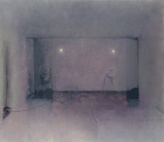 There
is an iron bar (curtain holder) wedged into the two sides of the narrow
space confined by white walls, in the back there is a swing door inside
the floor, and in the front, there is a table, which is used for reading
out the sentence, and there are two chairs behind it. On the painting of
Attila Szûcs the space covered in lilac-grey glazing is "filled with"
objects: plastic tubes winding across the cell, a ladder and a bucket on
the left, on the right a small table which looks half covered just like
the wash-basin next to it. The table and the two chairs are missing. In
their place there is a homogenous streak, which is perhaps the just commenced
draft of the covered table. The flash-like white light of the small square
openings on the back wall breaks up the claustrophobic confinement of the
space. It is left up to our imagination what we would use the objects for,
what the scene is for which this setting provides the background, which
one of our nightmares takes place in a similar venue. The surface sprinkled
with pigments creates a transparent effect, and through the "multi-phase"
of the picture the document which started off the painting fades and dissolves,
and a half-dream-like situation is reconstructed.
There
is an iron bar (curtain holder) wedged into the two sides of the narrow
space confined by white walls, in the back there is a swing door inside
the floor, and in the front, there is a table, which is used for reading
out the sentence, and there are two chairs behind it. On the painting of
Attila Szûcs the space covered in lilac-grey glazing is "filled with"
objects: plastic tubes winding across the cell, a ladder and a bucket on
the left, on the right a small table which looks half covered just like
the wash-basin next to it. The table and the two chairs are missing. In
their place there is a homogenous streak, which is perhaps the just commenced
draft of the covered table. The flash-like white light of the small square
openings on the back wall breaks up the claustrophobic confinement of the
space. It is left up to our imagination what we would use the objects for,
what the scene is for which this setting provides the background, which
one of our nightmares takes place in a similar venue. The surface sprinkled
with pigments creates a transparent effect, and through the "multi-phase"
of the picture the document which started off the painting fades and dissolves,
and a half-dream-like situation is reconstructed.
The recognition of the moments of "high density", along
their solitude, is characterised by passivity and inertia which create
a distance mixed with fear. The reconstruction is the process of painting
for Luc Tuymans too, but it is the quick and resolute reconstruction of
the drawing as a formal and spiritual model in which the obvious questions
of the picture are clarified and all unnecessary details disappear. The
aim of the radical distancing and viewpoint of the paintings is to confront,
often to shock, the viewer with the identity, status of the picture and
the questions and problems relating to the strategies of automatically
superficial viewing which lacks real attention.
Tuymans reduced his picture of Lamp room
(1992)9 or the series
Sealed Rooms (1990) to only the most necessary paintbrushes
and raster of shades. On the pictures bordering on the figurative and the
abstract, the barren venues laden with the weight and secret of an obvious
crime or tragedy are being outlined from the mosaics of definite lines
and dark and light streaks. 
The differences of approach in the evoking of the "high
density moments", related to the Reconstructed Execution Place concretely,
can be best attained in such works as the Gas Chamber
(1986), where Tuymans touched a specially sensitive group of documents
and depictions with the photo used as basic motive. The empty venues of
the Holocaust, the tragedies which happened there, and the worldly frames
of the taboos of violence which still cannot be comprehended, evoked or
depicted, document the venue of "a domain which cannot be opened
visually", as Géza Komoróczy put it.10
On this picture, similarly to other works of Tuymans, the same one condition,
continuously repeating itself, washes away all the other possibilities.
On the picture of Reconstructed Execution Place,
it is not the horror coming from the function of the space which is reconstructed
with the projection of various, sometimes broken up, or amended scenes
on each other but the process which is fiddling with the objects. With
this work, similarly to the 'clean-rooms', Attila Szûcs creates a
'state of in-between', which testifies that there are other conditions
existing simultaneously with the conditions of along, before and after.
Notes
1. Ian McEwan: Black Dogs, Vintage, 1998 p. 144-145
2. "The not-knowing is just as important as the knowing. We should
not strive to know everything but to draw more precisely the circles of
not-knowing and knowing. The two circles would overlap each other and cut
out the relationship of the condition." Péter Nádas: Talált
cetli, Jelenkor Kiadó, Pécs, 1992, p.33.
3. "Túl sok ebbôl a világból" in: Jean Baudrillard:
Az utolsó elôtti pillanat. Beszélgetések Philippe
Petit-vel. Magvet, Budapest, 2000, p. 51.
4. Miklós Peternák: Beszélgetés Vilém
Flusserrel. replika.33-34 (1998, December): pp.77-79.
5. The exit point of the optic nerve is about 4 millimetres from the
optic socket towards the nose, and there are no cones and rods here. This
place is the blind spot (macula coeca) which is not sensitive to light.
There are no sensory cells on the retina where the optic nerve breaks the
retina. Therefore there is always a part of space on our visual area which
we do not sense. This is usually not disturbing because this area is at
different places in the two eyes, and our brain makes up for this gap on
the basis of the information provided by the other eye. The blind spot
on which no picture is formed is a mistake without which no vision is created.
6. Vilém Flusser: Az ágy in: Az ágy, Kijárat
Kiadó, Budapest, 1996, pp.55-56.
7. In a very general summary: "clean-room" was the name given to the
first room of a peasant house which was saved from the everyday filthy
work, and which gave room for the objects of wealth, furniture, presents
from the fairs signifying the position of the owners. It was often only
opened at special events, holidays, funerals or for a guest.
8. Luc Tuymans, Artist's Writings in: Luc Tuymans, Phaidon Press, London,
1996. 112.o.
9. On the picture, sliding slightly to the left from the middle axis,
there is a corner of a room with a door, and with ball shaped lights
hanging from three aluminium bars in the upper third of the streak spreading
from the corner to the right side of the picture. The door is only signalled
by a handle of a dark stroke and a dark shaded frame. The vertical stripe
of the right and left walls is only divided by one shade of yellowish-grey.
The shadows of the balls float like dark spots and disks behind the lights.
10. Zsófia Mihancsik: Visszaköpött imák. Komoróczy
Géza, Surányi Vera és Tatár György beszélgetése
a Holocaust-filmekrôl, Filmvilág, XLIII. évfolyam,
9. szám, 2000 September, pp. 4-7.
